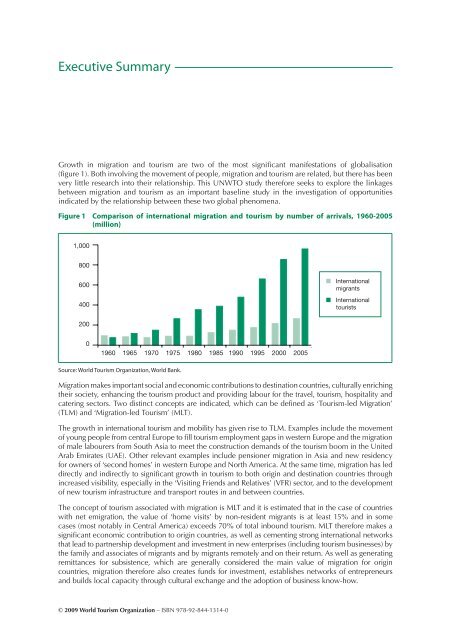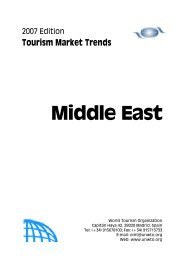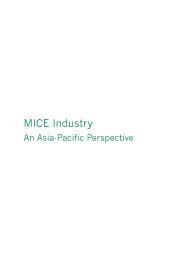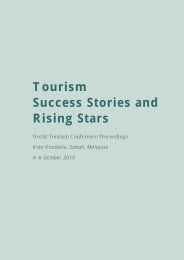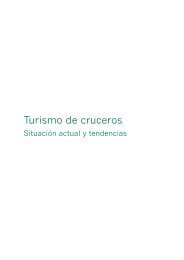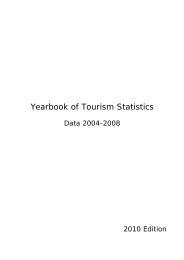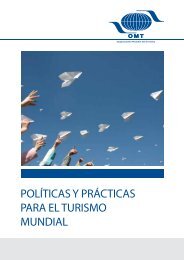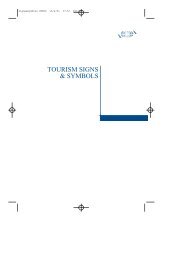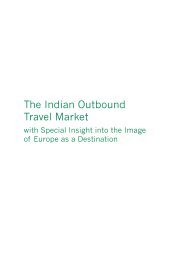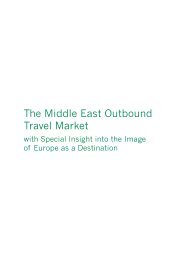Executive Summary - World Tourism Organization
Executive Summary - World Tourism Organization
Executive Summary - World Tourism Organization
You also want an ePaper? Increase the reach of your titles
YUMPU automatically turns print PDFs into web optimized ePapers that Google loves.
<strong>Executive</strong> <strong>Summary</strong><br />
Growth in migration and tourism are two of the most significant manifestations of globalisation<br />
(figure 1). Both involving the movement of people, migration and tourism are related, but there has been<br />
very little research into their relationship. This UNWTO study therefore seeks to explore the linkages<br />
between migration and tourism as an important baseline study in the investigation of opportunities<br />
indicated by the relationship between these two global phenomena.<br />
Figure 1 Comparison of international migration and tourism by number of arrivals, 1960-2005<br />
(million)<br />
1,000<br />
800<br />
600<br />
400<br />
International<br />
migrants<br />
International<br />
tourists<br />
200<br />
0<br />
1960 1965 1970 1975 1980 1985 1990 1995 2000 2005<br />
Source: <strong>World</strong> <strong>Tourism</strong> <strong>Organization</strong>, <strong>World</strong> Bank.<br />
Migration makes important social and economic contributions to destination countries, culturally enriching<br />
their society, enhancing the tourism product and providing labour for the travel, tourism, hospitality and<br />
catering sectors. Two distinct concepts are indicated, which can be defined as ‘<strong>Tourism</strong>-led Migration’<br />
(TLM) and ‘Migration-led <strong>Tourism</strong>’ (MLT).<br />
The growth in international tourism and mobility has given rise to TLM. Examples include the movement<br />
of young people from central Europe to fill tourism employment gaps in western Europe and the migration<br />
of male labourers from South Asia to meet the construction demands of the tourism boom in the United<br />
Arab Emirates (UAE). Other relevant examples include pensioner migration in Asia and new residency<br />
for owners of ‘second homes’ in western Europe and North America. At the same time, migration has led<br />
directly and indirectly to significant growth in tourism to both origin and destination countries through<br />
increased visibility, especially in the ‘Visiting Friends and Relatives’ (VFR) sector, and to the development<br />
of new tourism infrastructure and transport routes in and between countries.<br />
The concept of tourism associated with migration is MLT and it is estimated that in the case of countries<br />
with net emigration, the value of ‘home visits’ by non-resident migrants is at least 15% and in some<br />
cases (most notably in Central America) exceeds 70% of total inbound tourism. MLT therefore makes a<br />
significant economic contribution to origin countries, as well as cementing strong international networks<br />
that lead to partnership development and investment in new enterprises (including tourism businesses) by<br />
the family and associates of migrants and by migrants remotely and on their return. As well as generating<br />
remittances for subsistence, which are generally considered the main value of migration for origin<br />
countries, migration therefore also creates funds for investment, establishes networks of entrepreneurs<br />
and builds local capacity through cultural exchange and the adoption of business know-how.<br />
© 2009 <strong>World</strong> <strong>Tourism</strong> <strong>Organization</strong> – ISBN 978-92-844-1314-0
viii<br />
<strong>Tourism</strong> and Migration – Exploring the Relationship between Two Global Phenomena<br />
There are however some negative aspects and consequences (both real and perceived) of the relationship<br />
between tourism and migration, such as ‘brain drain’ and reduction in tax revenues in origin countries<br />
and wage deflation and social tension in destination countries. Nevertheless, it can be argued that<br />
these all represent opportunities that can be harnessed by the public and private sectors, although in<br />
some cases there is a lack of data available to quantify the opportunity. This means that there is a need<br />
to improve data capture through the adoption of common standards, especially in relation to VFR<br />
tourism and non-resident return visits, and in the short-term through targeted research and enhanced<br />
data collection in selected countries.<br />
In both origin and destination countries, there is an opportunity to better understand migrant profiles<br />
in order to inform marketing strategy. In origin countries, enhanced planning could lead to more<br />
effective investment and facilitate the return of highly skilled migrants. In destination countries which<br />
are members of the <strong>Organization</strong> for Economic Co-operation and Development (OECD), enhanced<br />
understanding of tourism gaps in the labour market could lead to changes in immigration policy and<br />
visa arrangements, which would benefit the tourism sector, increase tax revenues and help to alleviate<br />
poverty in Least Development Countries (LDC).<br />
In 2005, the Global Commission on International Migration published a report that encouraged states<br />
to maximise positive outcomes of international migration. However, whilst the report included more<br />
than 50 references to services (in particular services to be provided to migrants), the tourism-related<br />
services are mentioned twice in the context of migrant women and “migrants with irregular status”. At<br />
the same time, the Commission emphasised the importance of remittances, which are a focus of the<br />
present report in the context of tourism. In fact, remittances from migrants (US$ 303 billion in 2006,<br />
<strong>World</strong> Bank (WB)) and tourism receipts (US$ 742 billion in 2006, UNWTO) nourish daily the world<br />
markets and make viable the economic sustainability of the richest and some of the poorest nations in<br />
the world.<br />
This present report attempts therefore to contribute to the ongoing debate and research on the contribution<br />
of tourism and migrations to sustainable development. An important aspect of research will be to focus<br />
on the relationship between tourism and migration with respect to the generation of value added. Case<br />
studies in part facilitate this task.<br />
The report presents the conceptual framework for the analysis of linkages between migrations and<br />
tourism and the data on workers’ remittances and tourism. It further looks into features and trends of<br />
tourism and migration including social, societal and cultural impacts of MLT, national and regional<br />
policies in this area. Case studies of China, France, Germany, India, Japan, Philippines, Turkey, United<br />
Kingdom, United States of America and Central America illustrate themes and indicate findings, which<br />
are the basis of recommendations.<br />
In the course of this study the following key questions are considered:<br />
1. What is the economic impact of emigration on tourism in origin countries<br />
2. What contribution to the tourism economy is made by immigrant workers in destination<br />
countries<br />
3. What investments are made in tourism in origin countries as a result of emigration<br />
4. What trends can be identified in tourism-related migration and migration-related tourism<br />
This study focuses on the implications of migration for tourism. Drawing on this framework, a series<br />
of conclusions, presented as specific recommendations, have emerged through an analysis of case<br />
studies.
<strong>Executive</strong> <strong>Summary</strong><br />
ix<br />
Key Findings and Associated Recommendations<br />
Table 1 Key findings and recommendations<br />
Finding<br />
MLT can significantly contribute to<br />
development and poverty<br />
alleviation.<br />
Migrants’ remittances can<br />
constitute a powerful instrument<br />
for enhancing tourism-related<br />
investments in basic infrastructures<br />
at community-based level or for<br />
creating small tourism businesses in<br />
the origin countries.<br />
Some countries are better at<br />
utilising migration flows than<br />
others.<br />
The lower the level of development<br />
in origin countries, the greater the<br />
contribution of migration.<br />
Institutional changes are required<br />
to accompany and assist migration<br />
flows in order to harness their<br />
economic and social benefits,<br />
including the field of tourism<br />
development.<br />
Inconsistency of data and diversity<br />
of situations prevent to<br />
quantitatively demonstrate linkages<br />
between tourism and migration.<br />
Restrictions on immigration in<br />
highly developed countries are<br />
restricting tourism development.<br />
Migration from origin countries is<br />
leading to a ‘brain drain’ and ‘skill<br />
drain’ in less developed countries.<br />
Diaspora networks represent a<br />
critical factor in development.<br />
Recommendation for<br />
origin countries<br />
Permit migration and encourage<br />
VFR tourism.<br />
Avoid overdependence on tourism<br />
prospects.<br />
Promote tourism as a target sector<br />
for investment of remittances.<br />
Avoid ‘double taxation’ on returning<br />
migrants who wish to develop new<br />
tourism enterprises.<br />
Permit FDI in tourism, but<br />
encourage active management by<br />
indigenous partners.<br />
Identify areas in which country<br />
needs to develop know-how and<br />
which can benefit from the<br />
promotion of specific emigration<br />
programmes.<br />
Permit migration to areas where<br />
there are opportunities to gain<br />
relevant know-how.<br />
Negotiate employment conditions<br />
and specific apprentice schemes<br />
with destination countries.<br />
Differentiate outbound VFR<br />
movements and inbound emigrant<br />
visits within travel and tourism<br />
statistics in order to understand<br />
MLT and develop marketing<br />
strategies.<br />
Negotiate visa arrangements with<br />
key destination countries.<br />
Facilitate return of emigrants with<br />
tourism management and<br />
entrepreneurial skills.<br />
Encourage enterprise development.<br />
Maintain official contact with<br />
migrant communities.<br />
Recommendation for<br />
destination countries<br />
Research migrant profiles and<br />
networks in order to develop<br />
effective marketing strategy and<br />
new revenue streams.<br />
Reduce charges and restrictions on<br />
remittance transfers.<br />
Encourage sharing of know-how in<br />
order to promote international<br />
partnerships.<br />
Identify knowledge and resource<br />
gaps and seek to address these<br />
through targeted immigration<br />
promotion policies.<br />
Encourage cooperative policies to<br />
fight poverty in LDC in line with<br />
Millennium Development Goals<br />
(MDG).<br />
Trade unions and employer<br />
organizations need to ensure<br />
protection of migrant workers.<br />
Employment rights of native<br />
workers should also be extended to<br />
immigrant workers.<br />
Special protection needs to be<br />
given to female immigrants.<br />
Differentiate VFR tourism in order to<br />
understand MLT and develop<br />
appropriate marketing strategies.<br />
Reconsider ‘points’ systems that<br />
discriminate workers in tourism and<br />
hospitality sectors.<br />
Provide immigrants working in<br />
tourism and hospitality with access<br />
to internationally recognized<br />
‘certified’ training and apprentice<br />
schemes.<br />
Engage opinion leaders within<br />
immigrant communities as a part of<br />
marketing strategy for migrationrelated<br />
tourism.
x<br />
<strong>Tourism</strong> and Migration – Exploring the Relationship between Two Global Phenomena<br />
The complexity of this assignment needs some clarifications regarding the scope and coverage of<br />
the report and the conclusions and recommendations it entails. First, the objects of analysis are the<br />
flows of international migrant workers and visitors and their ties with their origin and destination,<br />
primarily, but not exclusively, from an economic perspective. Second, political refugees and relocation<br />
of people for humanitarian reasons are excluded. Third, rather than producing common themes and<br />
recommendations, the case studies present a whole diversity of situations between the selected countries<br />
concerned representing different levels of development, geographical regions and the categories of<br />
migrants, leading to a ‘shopping list’ of recommendations rather than a single homogenised roadmap.


